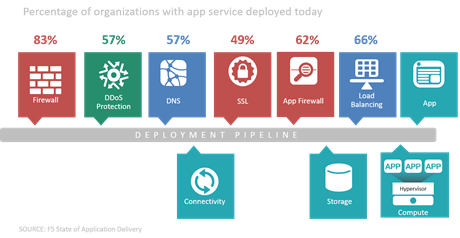SDDC: 運用効率と安定性および予測可能性のバランスをとる
SDDC (ソフトウェア定義データセンター) や DevOps などのアジャイル重視の方法論やアーキテクチャへの関心は、速度と安定性という 2 つの主要な目標の達成に大きく傾いています。 前者の場合、ほぼあらゆる規模の組織の運用環境を間違いなく管理するデプロイメント パイプラインを通じてアプリをプッシュするのにかかる時間を短縮することで、市場投入までの時間を改善することが目的です。
実稼働環境がビジネス全体をサポートするという理由だけでも、安定性は必須です。 これは主要なネットワークであり、重要なアプリケーションであり、良いものも悪いものも含めたすべてのビジネス信号が流れる神経系です。 混乱は許容されません。 ダウンタイムによって誤った構成やその他のエラーが引き起こされた場合、その影響範囲は大きくなります。 安定性は、アプリケーションが開発から展開まで移動する速度を向上させる必要性とバランスを取る必要があります。
これは、主に環境の複雑さのため、簡単な作業ではありません。 これは単なる新しいサーバー、いくつかのソフトウェア、そしてネットワークではありません。 これは、アプリ インフラストラクチャだけでなく、アプリ サービス インフラストラクチャも含む、高度に統合された接続セットです。 このアプリ サービス インフラストラクチャも、ネットワーク図で示されるほど単純ではありません。 これは、単にファイアウォール、ロード バランサ、アプリというだけではありません。実際には、セキュリティ、スケール、パフォーマンス、アクセスにわたる、より堅牢なサービス セットです。 それぞれを新たにプロビジョニングする必要があり、必ず構成する必要があり、最終的な消費者から実際のアプリケーションへの適切なトラバーサルを保証するために適切なネットワーク サポートが確実に必要になります。 組織は、アプリケーションを配信および保護するために、平均して 11 種類の異なるアプリ サービスを採用しています。 そして、これらの組織が平均 500 種類のアプリケーションをサポートしていることを考えると、実稼働環境自体が実際には非常に複雑なサービス インターネットである理由がよくわかります。

これがアプリ展開の現実であり、市場投入までの時間の短縮や展開の効率化を実現する上で、ネットワークが依然として「障害」になっているとよく思われる理由です。
SDDC: 安定性を犠牲にすることなくスピードを実現
速度と安定性のバランスをとることこそが、SDDC (Software-Defined Data Center) のような取り組みが目指すものです。 中央データセンターのコマンド アンド コントロール システムを通じて自動化とオーケストレーションを導入することで、組織はアプリケーションの配信とセキュリティ保護に必要な豊富なアプリ サービスをより適切に管理できるだけでなく、アプリ サービスが展開されるプロセスを監視、測定、改善することもできます。
問題は、真のエンタープライズ クラスの展開パイプラインに必要な幅広いサービスを単独のベンダーだけで提供できないことです。 ネットワーク サービスのプロバイダーは、すべてのアプリ サービスなどのプロバイダーではありません。
つまり、プロビジョニングと管理を自動化およびオーケストレーションすることで、実際にデプロイメント パイプラインを最適化し、変動性を削減しようとする場合は、エコシステム アプローチを採用する必要があります。 一貫性があり、シームレスで、繰り返し可能な一連の本番展開プロセスを確保するために、紙の上だけでなく本番環境でも連携する統合パートナーのエコシステム。
VMware や F5 などのパートナーは、長年にわたり、SDDC などの取り組みで組織が成功できるようにする共同ソリューションの開発と実装に注力していることを実証してきました。
アプリケーション (およびビジネス) に必要なパフォーマンス、可用性、セキュリティ サービスを提供するために重要と考えられるサービスの運用上の俊敏性を実現することは、困難な場合があります。 利用可能な IT リソースの大部分を消費せずにこれを一貫して行うことは、さらに困難になります。 VMware NSX や VMware vRealize Orchestrator を使用して VMware と F5 を一緒に導入することで、組織はアプリケーションの可用性とセキュリティを維持するために必要なアプリケーション サービスを迅速かつプログラム的にプロビジョニングできます。 私たち(VMware と F5)は、ソフトウェア定義データセンター(SDDC)で力を合わせ、さまざまなアプリケーション向けのアプリケーション ネットワーキング サービスのオーケストレーションを改善してきました。
クラウドでも。
これは重要なことです。なぜなら、今は単なるクラウドの世界ではなく、ハイブリッド クラウドの世界だからです。 少なくとも、当社の最新のアプリケーション配信の現状に関する調査では、回答者の 81% がそう答えています。 つまり、VMware NSX や vRealize Orchestrator などのオーケストレーションおよび管理ソリューションと統合するだけでは不十分であり、クラウドでのアプリケーションの配信とセキュリティ保護を担当するサービスもクラウドに展開できることが不可欠です。 そのため、vCloud Air に F5 ソフトウェアを導入し、導入場所に関係なくアプリケーションの可用性、パフォーマンス、セキュリティを確保する機能も提供しています。 F5 による単一のサービス配信プラットフォームの一貫性と、データセンターと vCloud Air の両方における VMware による統合プロビジョニングおよび管理により、俊敏性の向上、コストの削減、セキュリティの強化、パフォーマンスの向上、信頼性の向上が実現します。
これにより、「ネットワーク」が不要になり、ビジネスニーズの安定性と予測可能性を犠牲にすることなく、市場投入までの時間が短縮され、運用効率が向上します。
すべてがうまく聞こえますが、実際にやってみないとわからないというのが通説ですが、F5 は、ビジネスの需要を満たすためにVMware Horizon を拡張する、この新しい SDDC オーケストレーションおよび自動化ソリューションを、サンフランシスコで開催される VMworld 2015 でデモする予定です。 参加者には、このデモを体験するための 2 つのオプションがあります。9 月 2 日午前 8 時のブレークアウト セッションNET6320-SPOと、イベント期間中のブース #1513 です。
